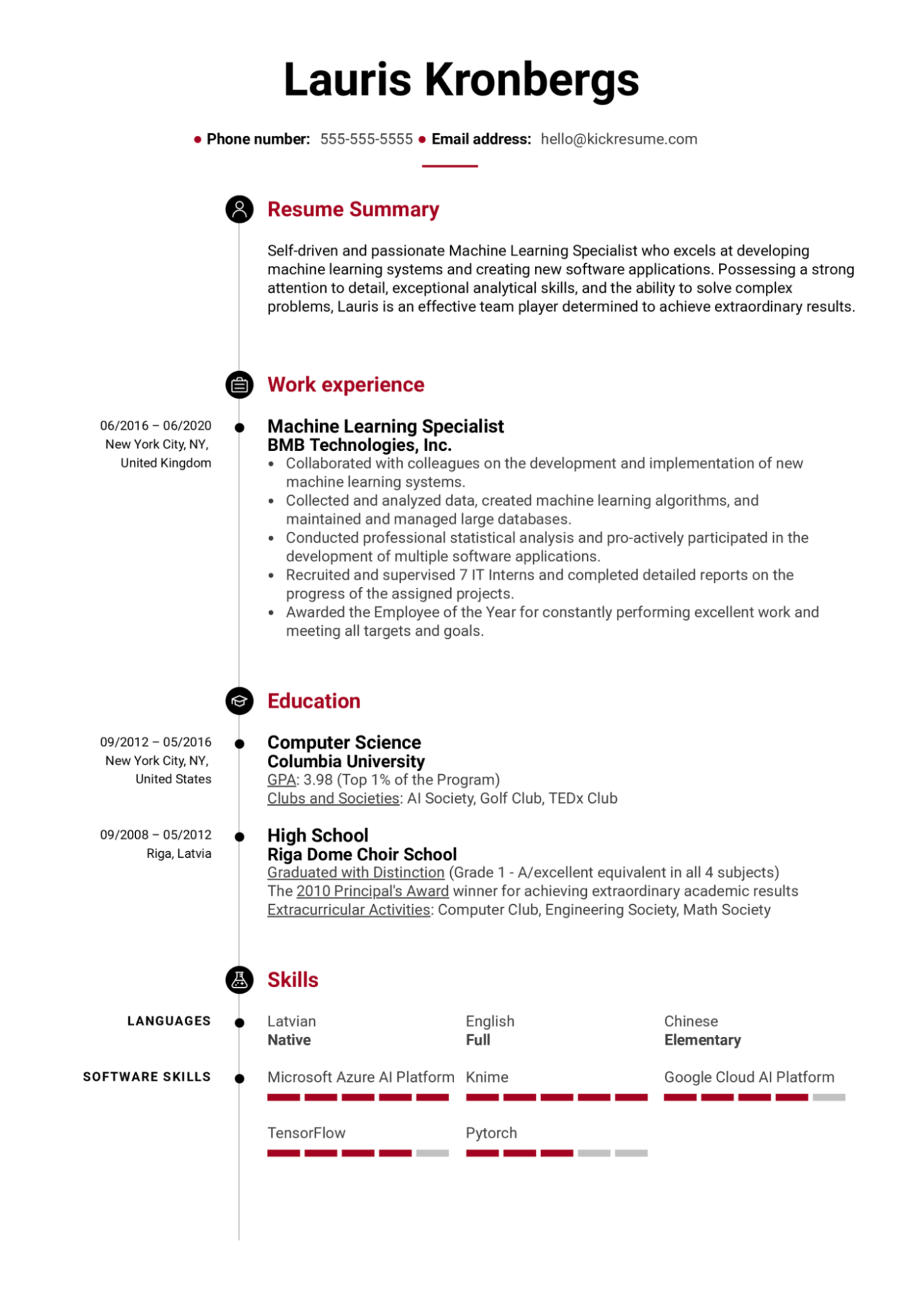A meticulously designed resume can be your ticket to unlocking employment prospects and securing your dream job in the extremely competitive field of machine learning. This comprehensive guide provides essential insights into strategically optimizing your Machine Learning resume to impress employers. Learn how to write a Machine Learning resume that propels you to professional success and fosters career advancement. Master effective strategies to highlight your technical expertise, present relevant projects, and leverage your industry knowledge.
Table of contents
- Machine Learning Resume Structure and Formatting
- Highlighting Relevant Skills and Knowledge
- Showcasing Machine Learning Projects
- Demonstrating Education and Certifications
- Quantifying Achievements and Impact
- Optimizing Resume for ATS
- Key Factors for Landing Your Dream Job
- Pro Tips for Creating a Winning ML Resume
- Machine Learning Specialist Resume Sample
- Machine Learning Engineeer Resume Sample
- Conclusion
- Frequently Asked Questions
Machine Learning Resume Structure and Formatting
Presenting your skills and experiences in the right format is crucial for ensuring that your Machine Learning resume stands out.
Structure
- Professional Header
- Concise Summary/Objective Statement
- Technical Skills
- Education
- Work Experience
- Projects
- Certifications and Training
- Publications and Presentations
- Awards and Recognition
- Professional Affiliations
- References
Format
Consider the standard details for a well-structured and neat AI ML resume:
- Fonts
- Font Size
- Line Spacing
- Allignment
- File Type
Highlighting Relevant Skills and Knowledge
To highlight your relevant skills and knowledge in the machine learning engineer resume, include the following keywords:
| Aspect | Skills and Techniques |
|---|---|
| Machine Learning Algorithms | Linear, logistic, decision trees, deep learning, random forests |
| Programming Languages | Python, R, MATLAB |
| Libraries and Frameworks | Keras, TensorFlow, PyTorch, pandas, scikit-learn |
| Data Preprocessing and Feature Eng. | Data cleaning, normalization, transformation, feature extraction |
| Data Manipulation Tools | NumPy, pandas |
| Model Evaluation and Validation | Cross-validation, accuracy, recall, precision, AUC, F1-score |
| Data Visualization | Matplotlib, Seaborn |
| Big Data and Distributed Computing | Spark, Hadoop |
| Domain Knowledge | Computer vision, recommendation systems, NLP, time series analysis |
| Collaboration and Communication | Stakeholder collaboration, teamwork, explaining ML to non-tech audiences |
| Continuous Learning | Relevant courses, workshops, certifications, competitions |
| Problem-Solving and Analytical Thinking | Problem analysis and machine learning application to complex projects |
Showcasing Machine Learning Projects
The following is the suggested format for presenting your machine-learning projects in an ML resume:
- Project Title
- Project Overview
- Data Description
- Methodology
- Results
- Visualization and Interpretation
- Impact and Contributions
- Technical Skills Demonstrated
- Team Collaboration
- GitHub or Portfolio Links
Remember to prioritize projects that are closely related to machine learning and provide enough context for recruiters and hiring managers to comprehend the extent and magnitude of what you do.
Demonstrating Education and Certifications
Education:
- Degree or highest level of education along with the field of study
- University/Institution where you obtained your degree.
- Graduation Year
- Bullet points with information about your participation in extra-curricular
Certifications:
- Certification name
- Issuing authority that provided the certification
- Year you obtained the certification
Specializations or Concentrations:
- For example, “Concentration in Natural Language Processing.” or “Specialization in Computer Vision.”
Capstone or Thesis Projects:
- A brief overview of the project
- Objectives
- Methodologies and outcomes
Academic Achievements:
- Academic honors
- Awards
- Scholarships
Relevant Workshops or Seminars:
- Workshops, seminars, or conferences attended on machine learning.
- Include the event name, year, and any specific topics covered.
Online Courses / Conferences / Workshops
- You can add all the certifications you acquire through workshops, conferences, hackathons, online courses, etc. For example Blackbelt program or DHS attendance certification.
Quantifying Achievements and Impact
To create a job-winning resume, it is best to be mindful of the following tips:
- Use numbers and metrics
- Highlight business or performance improvements
- Showcase data-driven results
- Highlight scalability and efficiency improvements
- Mention data volume or scale
- Use time-related metrics
- Focus on ROI or cost savings
Optimizing Resume for ATS
Consider the following tips to develop a resume for an Applicant Tracking System:
- Use relevant keywords according to the job description and tailor the resume to the job to pass the ATS screening
- Use standard section heading like Summary, Education, Experience, Skills, and Projects.
- The formatting has to be simple and consistent.
- Optimize file compatibility
- Include Relevant Skills Section
- Emphasize ML projects
- Incorporate industry keywords
- Avoid abbreviations/acronyms/jargon
- Proofread and review
Key Factors for Landing Your Dream Job
Technical Expertise
Build a solid Machine Learning foundation, keep yourself up-to-date and constantly develop technical abilities through projects, open-source contributions, and research articles.
Networking
Connect with ML community professionals through conferences, webinars, meetups, social media groups, online forums, and platforms like GitHub for valuable information, employment referrals, and mentorship.
Practical Experience
Experience with machine learning through real-world applications, ML projects, portfolio development, and contests to demonstrate problem-solving and competence.
Continuous Learning
Demonstrate commitment to continual learning in machine learning by participating in online classes, workshops, and tutorials, obtaining certificates from credible sites like Analytics Vidhya, Coursera, or edX, and staying current on trends and innovations.
Domain Knowledge
Improve your worth as an ML specialist by gaining knowledge in a specialized topic, for example, computer vision, NLP, finance, autonomous systems, or healthcare.
Collaborative Skills
As ML frequently requires teamwork, demonstrate your ability to interact successfully. Highlight any experience working in multidisciplinary teams or cooperation between industry and academics. Highlight your communication abilities, versatility, and eagerness to learn from others.
Research and Publications
Participate in ML research by releasing papers at conferences, workshops, or journals. Experience conducting research displays your ability to delve deeply into ML topics, undertake experiments, and contribute to the larger ML community. Highlight any significant research contributions.
Communication and Presentation Skills
ML experts must effectively communicate complex concepts to stakeholders with limited technical knowledge, showcasing clear communication skills through verbal and written communication, technical reports, presentations, and non-technical teaching.
Tailored Resumes and Cover Letters
Customise your resume and cover letter to match the job criteria for machine learning, highlighting relevant abilities, experiences, and projects, employing keywords, and displaying the company’s mission and objectives.
Interview Preparation
Practise ML algorithms, coding questions, and data analysis problems to prep up for ML job interviews. Prepare to explain your projects and technical judgments by reviewing ML concepts. During the interview, demonstrate your critical thinking skills, problem-solving ability, and enthusiasm for machine learning.
Pro Tips for Creating a Winning ML Resume
- The design you use should be clutter-free design.
- The entire resume should not be filled with text.
- Paragraphs are less attractive, so it is good to use bullet points.
- Active voice enhances readability.
- The use of simple vocabulary and shorter sentences are a must.
- Scan the job description for requirements and the same words (if applicable) to your resume. These serve as keywords and help your resume pass ATS.
- Avoid having too much content on one page; use more if necessary, but keep the quantity to a minimum.
- Edit to create a concise, visually appealing, and comprehensive resume for recruiters.
- Make use of popular online tools like Grammarly to check your resume for grammar, fluency, engagement, clarity, etc.
- Get third-party proofreading done for genuine advice, preferably from friends or colleagues.
- Most importantly, customize your resume for every job specifically. Do not use the same resume for all.
Machine Learning Specialist Resume Sample

Machine Learning Engineeer Resume Sample

Conclusion
Make a strong machine learning resume by emphasizing technical abilities, relevant projects, and industry knowledge. Customize your resume for specific roles and measure your achievements. This article offers advice on how to structure and highlight crucial achievements in order to grab the attention of potential employers and secure your ideal job.
You can add some of these machine learning projects to your resume. If you need guidance in solving these projects, then you must consider taking up our blackbelt program! Get 1:1 mentorship, solve real world projects and learn latest ML topics from experts. This is your chance to become fullstack ML Engineer!
Frequently Asked Questions
A. In the skills part, include machine learning, and in the experience section, emphasize relevant ML projects, algorithms, tools and techniques.
A. Machine learning techniques, frameworks (TensorFlow, PyTorch), programming languages (Python, R), data preprocessing, domain expertise, and model evaluation.
A. An ML CV (Curriculum Vitae) is a document that summarises a person’s academic credentials, ML abilities, research experience, publications, and ML-related initiatives. It is more detailed than a resume.
A. Yes, machine learning projects enhance resumes by demonstrating problem-solving ability, practical application of skills and real-world effects in the field of ML.




